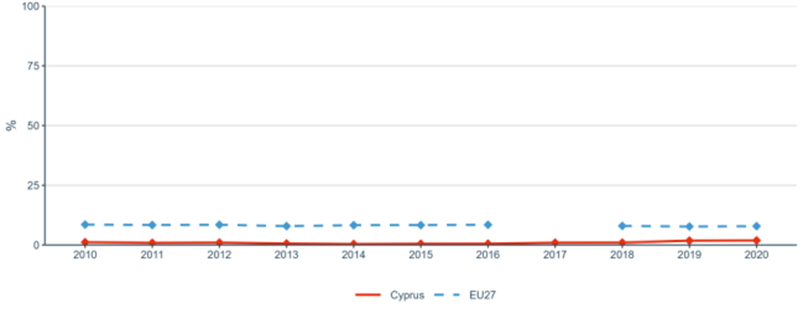ERA Country Report 2023
Cyprus
Edited by Christina Kakderi (Independent Science, Technology and Innovation policy expert)
as part of ‘Development of the ERA Scoreboard, the ERA Dashboard and the Regular Reports’ project for the European Commission, Directorate-General for Research and Innovation under Framework Contract N° 2018/RTD/A2/OP/PP-07001-2018 Lot 2 (EDAR)
Click here to download this country report![]()
- Table of contents
-
ERA Country Report 2023: Cyprus
1. National context
1.1. Overview of the ERA policy agenda implementation
1.2. Policy context
2. Assessment of the Implementation of the ERA Policy Agenda and ERA Priorities
2.1. ERA Priority 1: Deepening a truly functional internal market for knowledge
2.2. ERA Priority 2: Taking up together the challenges posed by the twin green and digital transition and increasing society’s participation in the ERA
2.3. ERA Priority 3: Amplifying access to research and innovation excellence across the Union
2.4. ERA Priority 4: Advancing concerted research and innovation investments and reforms
3. Country-specific drivers and barriers
4. Final remarks
5. Bibliography
6. Annexes
6.1. Annex 1: Graphs
ERA Country Report 2023 Cyprus
|
Key takeaways:
|
1. National context
1.1. Overview of the ERA policy agenda implementation
Cyprus is a strong innovator according to the European Innovation Scoreboard (EIS) 2023, with performance at 105.4% of the EU average. The country’s performance has been improving over time due to the innovation performance of the business sector.^
Cyprus is committed to ten ERA Policy Actions covering all four priority areas of the ERA Policy Agenda. The main tool for promoting the ERA Policy Agenda and its actions is the new Research and Innovation Strategy 2024-2026, prepared by the Deputy Ministry of Research, Innovation and Digital Strategy (DMRID) and approved by the Ministerial Council on 7 December 2023. The strategy is harmonised with the EU research and innovation (R&I) policy, and it is aligned with European Research Area (ERA) priorities and actions, while its sectoral focus is based on priorities identified in the Smart Specialisation Strategy 2030. In addition, several key cross-sectoral strategies, such as Cyprus’ Space Strategy 2022-2027 and Digital Skills Action Plan., contribute to implementing the ERA Policy Agenda.
1.2. Policy context
The DMRID, established in March 2020, is the competent government authority responsible for promoting scientific excellence, nurturing creativity and entrepreneurship, facilitating innovation, supporting the extroversion and international cooperation of the national R&I ecosystem and accelerating the digital transformation (governance, infrastructure, skills and enterprises). Specifically, the Directorate for R&I of the DMRID has the following competencies: (1) design, promote and monitor the implementation of the National R&I Strategy and relevant policy measures; (2) supervise and support the operations of the national R&I governance system; (3) provide guidance and supervise the Research and Innovation Foundation (RIF) and (4) represent Cyprus to the European Union, and design and promote bilateral and multilateral science and technology cooperation agreements.
The Research and Innovation Foundation (RIF) is the national authority in charge of supporting and promoting research, technological development, and innovation in Cyprus. Through innovative actions and programmes, RIF reinforces the domestic R&I ecosystem, contributes to strengthening cooperation and networking among the ecosystem as well with the international research and entrepreneurial communities.
The National Research and Innovation Strategy for 2024-2026 capitalises on the significant advancements made over the past decade. It is based on previous national strategies, such as the Strategic Framework for Research and Innovation 2019-2023 "Innovate Cyprus" and the long-term strategy of the Cypriot economy "Vision 2035", while taking into account relevant EU R&I policies, such as the ERA, the EU Framework Programme for R&I "Horizon Europe" and the “New European Innovation Agenda".
Furthermore, the national strategy includes the introduction of a new monitoring and assessment mechanism for publicly funded organisations as well as an assessment mechanism for the socioeconomic impact of R&I. It also contains measures and investments for the support and development of World-Class Institutions & Infrastructures for ground-breaking research, (Pilar A), Linking R&I with Businesses, Fuel Business Success, (Pillar B), focusing on People as drivers of growth for the R&I Ecosystem (Pillar C) and becoming an R&I Leader within the EU and beyond (Pillar D). The thematic orientation is based on priorities identified by the Smart Specialisation Strategy (Thematic Pillar). The strategy is accompanied by an Action Plan outlining measures, actions, and initiatives for each strategic pillar and priority, with a particular focus on funding programmes.
Regarding the targets and priorities of the European Green Deal, in 2021, a new National Governance System was introduced to coordinate the implementation of national actions and the revision of the National Energy and Climate Plan (NECP). The DMRID oversees the Technical Committee titled "Research, Innovation, Digitalisation and Competitiveness" which coordinates the formulation of recommendations for the contribution of the R&I ecosystem in this policy.
2. Assessment of the Implementation of the ERA Policy Agenda and ERA Priorities
This chapter has two objectives: 1) It qualitatively assesses the state-of-play of the implementation of the ERA actions that Cyprus has committed to. The qualitative information stems from the OECD STIP survey 2023 and additional desk research; 2) It quantitatively assesses the country’s progress towards achieving the ERA priorities as set out on the Pact for Research and Innovation in Europe. The presented quantitative information is mainly based on the ERA Scoreboard and ERA Dashboard indicators and covers longer-term trends since 2010. Additionally, general indicators for the overall R&I system are outlined in Table 1. More detailed information on the data and graphs can be found in Annex 1.
| Indicator |
Most recent EU average |
Most Recent Metric |
| Gross Domestic Expenditure on R&D (GERD) as a percentage of GDP |
2.26 (2021) |
0.87 (2021) |
| Government Budget Allocations for R&D (GBARD) as a share of GDP |
0.76 (2021) |
0.46 (2021) |
| Researchers (in full-time equivalent) per million inhabitants |
4,483.4 (2021) |
1,813.6 (2021) |
| Business Enterprise expenditure on R&D (BERD) as a percentage of GDP |
1.49 (2021) |
0.4 (2021) |
Source: compiled by research team based on the ERA Scoreboard and ERA Dashboard indicators
2.1. ERA Priority 1: Deepening a truly functional internal market for knowledge
2.1.1. State of play in the implementation of the ERA Actions
With regard to ERA Action 1: Enable Open Science, including through the European Open Science Cloud (EOSC), open access practices in Research Performing Organisations (RPOs) are included within the priorities of Pillar A of the National Research and Innovation Strategy 2024-2026. The National Policy for Open Science (OS) approved by the Ministerial Council on 27 May 2022, is aligned with EU OS policy initiatives and ERA Action 1. Additionally, open science practices are included as a requirement by the RIF for the national funding programs.
In relation to ERA Action 4: Promote attractive research careers, talent circulation and mobility, Pillar C of the National R&I Strategy 2024-2026 supports the career development and prospects of researchers. This involves promoting the "European Charter for the Researcher” and the “Code of Conduct for the Recruitment of Researchers" to domestic organisations, adopting best practices and creating an integrated framework for researchers. Measures include attracting and repatriating talent from abroad as well as educating, training and empowering researchers. Cyprus also implements the scheme “scientific visa” which foresees fast-track procedures for facilitating the development of hosting agreements between research organisations and third country researchers. Furthermore, the RIF coordinates as Bridgehead Organisation the EURAXESS activities in Cyprus.
Towards ERA Action 5: Promote gender equality and foster inclusiveness, Pillar C of the National R&I strategy addresses the implementation of gender equality principles in R&I. This is achieved through a National Strategy for Gender Equality 2024-2026 adopting best practices and creating an integrated framework to ensure equal opportunities in terms of employment, training, and development.
ERA Action 7: Upgrade EU guidance for a better knowledge valorisation is promoted through Pillar B of the National R&I Strategy 2024-2026, which focuses on the exploitation of R&I and the engagement of SMEs. It aims to improve the output of new or improved products and services to the market, as well as the diffusion and adoption of innovation in the public sector. The RIF has established a central Knowledge Transfer Office (KTO) that provides knowledge transfer support to academic and research institutions in Cyprus and knowledge-intensive SMEs and startups.
For ERA Action 8: Strengthen sustainability, research infrastructures, Cyprus participates in the European Strategic Forum for Research Infrastructures (ESFRI), the European Research Infrastructures Consortium (ERIC) and the Research Infrastructures configuration of the Horizon Europe Programme Committee. Moreover, it actively participates in eight ESFRI Landmarks and is planning to update the National ESFRI Roadmap. A key focus of Pillar A of the National R&I Strategy is to enhance collaboration through the sharing of research infrastructures. To enable this, DMRID has launched a dedicated platform to facilitate collaboration and access to research infrastructures and networking tools. The mapping of existing as well as the development of new research infrastructures is also mentioned as an action of the strategic pillar 3 (Research Excellence) and 4 (Knowledge Transfer and Commercial Exploitation) of the Innovate Cyprus 2019-2023 strategy. The RIF has also launched two calls for funding research infrastructures. The first call is for the establishment of RI of strategic importance and the second for small scale research infrastructures.
In regard to ERA Action 9: Promote international cooperation, in Pillar D of the National R&I strategy 2024-2026 particular emphasis is placed on international networking and cooperation, as well as the meaningful contribution to the global R&I landscape. Cyprus is establishing 14 targeted bilateral agreements with countries possessing significant competitive advantages in key priority areas. As such, importance is given to optimising frameworks and incentives to foster international research networks and collaborations and to tap into global knowledge and expertise. Cyprus has also secured funding for seven Centers of Excellence for R&I (CoEs) through the Teaming action of Horizon 2020 and Horizon Europe with the aim of strengthening cooperation between the private and public sectors and to contribute to the internationalisation of Cyprus’ R&I system.
2.1.2. Progress towards achieving ERA Priorities
With regard to progress towards Sub-priority 1.1: Open science, the indicator Open access scientific publications with digital object identifier (DOI) as % of total scientific publications with (DOI) in Cyprus is lower than the EU-27 average. More specifically, although improved from 32.03% in 2009 to 38.33% in 2019, it has remained slightly below the EU-27 average which was 33.94% and 39.17% respectively (Figure 5 in Annex 1). Sub-priority 1.2: Research Infrastructures is measured through the number of European Research Infrastructures in which Cyprus participates in 2021, which is half the EU-27 average (Figure 6 in Annex 1).
Progress towards Sub-priority 1.3: Gender equality, equal opportunities for all and inclusiveness is analysed through different indicators. Cyprus scores lower than the EU-27 average in indicators such as Women in Digital Index, share of women in grade A positions in HEIs (Figure 7 in Annex 1)and proportion of papers with mixed gender authorship (Figure 9 in Annex 1). The proportion of women among doctoral graduates in STEM fields fluctuates in positions close to but higher than the EU average, apart from 2018 and 2020 that dropped to 26.45 and 35.23 compared to 37.83 and 37.35 of the EU-27 (Figure 8 in Annex 1). The proportion of women in authorships of the 10% most cited publications remained just below EU-27 average between 2010-2018 (Figure 10 the Annex 1). The Women in digital index for Cyprus in 2022 (Figure 11 in Annex 1) was below that of the EU-27 average as well.
ERA Sub-priority 1.4 focuses on Researchers’ careers and mobility and research assessment and reward systems. The share of foreign doctorate students as a percentage of all doctorate students shows similar trends to the EU-27 average both in absolute numbers and in trend, with Cyprus being slightly above the EU-27 average until 2018, when this trend was reversed (Figure 12 in Annex 1). In terms of new doctorate graduates per 1,000 inhabitants aged 25-34 (Figure 13 in Annex 1), Cyprus has remained consistently below EU-27 average since 2015, with this gap reducing in 2020 but picking up again in 2021. Job-to-job mobility of Human Resources in Science and Technology in Cyprus is much higher than the EU-27 average and increased after 2019, with a rate difference of 3.8 (10.5% of total employed HRST for Cyprus compared to 6.8% for the EU-27) (Figure 14 in Annex 1).
Analysing progress towards Sub-priority 1.5: Knowledge valorisation, there is a notable increase in the share of public-private co-publications after 2014, with a score in 2021 that is three times higher than the European average (395.09 for Cyprus compared to 133,89 of the EU-27) (Figure 15 in Annex 1). However, in the other two indicators that track the progress of knowledge valorisation, such as the number of PCT patent applications divided by GDP in million Euros and the share of innovating firms collaborating with higher education institutions or public/private research institutions, the position of Cyprus is either significantly lower than the EU-27 average (as in the first case) or lower but very close to the EU-27 average (as in the second) (Figures 16 and 17 in Annex 1).
Developments for Sub-priority 1.6: Scientific leadership is measured through the share of publications among the 10% most cited as a percentage of all publications (Figure 19 in Annex 1), which is slightly below the EU-27 average for the period 2015-2019, and marginally above in 2020 (with 10.4 compared to 9.8 of the EU-27). Moreover, the Academic Freedom Index in Cyprus (Figure 18 in Annex 1) is consistently above the EU-27 average since 2010.
The two indicators related to Sub-priority 1.7: Global engagement show results that vary significantly compared to the EU average. On the one hand, the share of international co-publications with non-EU partners in the public sector (Figure 20 in Annex 1) has increased considerably since 2010, reaching 3.385 publications compared to the much lower 358 of the EU-27 average in 2021. On the other hand, European and international co-patenting in EPO applications (Figure 21 in Annex 1) in Cyprus are constantly below the EU-27 average (although data only exists until 2013).
2.2. ERA Priority 2: Taking up together the challenges posed by the twin green and digital transition and increasing society’s participation in the ERA
2.2.1. State of play in the implementation of the ERA Actions
Cyprus has committed to ERA Action 10: Make EU R&I missions and partnerships key contributors to the ERA and is actively participating in European initiatives and partnerships to address societal challenges including the European Partnerships under Horizon Europe and EU Missions. Dissemination activities are being carried out among policy makers and national competent authorities to raise awareness and to ensure the alignment of national policies. Cyprus has committed EUR 18 million to co-finance the participation of the domestic R&I ecosystem in European Partnerships, attempting to intensify the links between national/regional R&I programmes and European Partnerships.
The environment and renewable energy are among the priorities of the National R&I Strategy 2024-2026, enhancing ERA Action 12: Accelerate the Green/Digital transition of Europe’s key Industrial Ecosystems. Furthermore, this action is promoted in Cyprus through the Smart Specialisation Strategy 2030 as well as the Cyprus Recovery and Resilience Plan 2021-2026. The RIF has launched a CO-DEVELOP (Green Transition) call in 2022 with a budget of EUR 6 million and another call is foreseen for 2024 with a budget of EUR 3 million. A focus on the green and digital transition is also evident in other strategic documents, such as the Digital Strategy 2020-2025. Cyprus has also introduced a national governance system to coordinate the implementation of national actions for the European Green Deal and the revision of the National Energy and Climate Plan (NECP) in cooperation with the R&I ecosystem.
2.2.2. Progress towards achieving ERA Priorities
Developments for Sub-priority 2.1 related to Challenge-based ERA actions are measured through different indicators (Figures 22-25 in Annex 1). The first indicator refers to Government Budget Allocations for R&D (GBARD) by NABS in energy; environment; transport, and telecommunications and other infrastructure (Figure 22 in Annex 1). The data available for all three areas is close to 0 and remains stagnant from 2010 to 2021, with the exception of the allocation for transport and other infrastructure that decreases along time. The second indicator shows the GBARD allocated to European transnational, bilateral, or multilateral public R&D programmes per FTE researcher in the public sector (Figure 23 in Annex 1). Although the figure shows significant fluctuations over the years, after 2015 the value for Cyprus is much higher than the EU-27 average (although with a declining trend after 2016). The indicator for the national public and private investments as suggested in the SET Plan progress report 2021 shows that the data for Cyprus is below the EU-27 average (Figure 24 in Annex 1). Significant fluctuations for Cyprus are also presented in the share of OECD patents on environmental technologies (Figure 25 in Annex 1).
Trends under Sub-priority 2.3:Synergies with sectorial policies and industrial policy, in order to boost innovation ecosystems are analysed through monitoring direct government support plus indirect government support through R&D tax incentives as a percentage of GDP (Figure 26 in Annex 1). The indicator shows that Cyprus’ position is below the EU-27 average. Although the budget share in the EU-27 average has slightly increased from 0.17% 0.18% between 2018 and 2020, in the case of Cyprus the increase has more than tripled (0.007% to 0.029% for the same years).
Sub-priority 2.4: An active citizen and societal engagement in R&I in all its dimensions shows that trust in science in 2021 (Figure 27 in Annex 1) was substantially higher in Cyprus compared to the EU-27 average. The research on social innovation (publications on 'social innovation' or 'social entrepreneurship') per million population (Figure 28 in Annex 1) has fluctuated considerably in Cyprus since 2015, presenting an increasing trend until 2020. On average it has been above the EU-27 average from 2028 until 2021.
2.3. ERA Priority 3: Amplifying access to research and innovation excellence across the Union
2.3.1. State of play in the implementation of the ERA Actions
In regards to ERA Action 16: Improve EU-wide access to excellence, Cyprus is taking action to increase the performance of the national R&I ecosystem through the exchange of best practices and lessons learned with other Member States and the Commission, with regard to Horizon Europe participation and complementarities with Smart Specialisation Strategies under the Cohesion policy. One of the key priorities of the new R&I strategy is the competitiveness of the national R&I ecosystem and the attractiveness of research institutions to international talent. Furthermore, a cornerstone of the strategy is the establishment of meaningful industry-academia collaboration.
2.3.2. Progress towards achieving ERA Priorities
In relation to Sub-priority 3.1: More investments and reforms in countries and regions with lower R&I performance, the available indicator measures the increase in total R&D expenditure expressed as a percentage of GDP. Figure 29 in Annex 1 shows that Cyprus has a performance very close but slightly higher (after 2017) than the EU-27 average.
2.4. ERA Priority 4: Advancing concerted research and innovation investments and reforms
2.4.1. State of play in the implementation of the ERA Actions
In relation to ERA Action 19: Establish an ERA monitoring system, Cyprus has committed to the establishment of monitoring mechanisms to measure, among other, the progress towards the SDGs. The monitoring mechanism introduced through the National R&I Strategy for the collection of necessary data at the national level and its analysis, to assess the impact delivered and guide the decision-making mechanism for the amendment of policy/strategy will work in tandem with the ERA monitoring system.
2.4.2. Progress towards achieving ERA Priorities
With regard to progress towards Sub-priority 4.1: Coordination of R&I investments the share of public R&D expenditures financed by the private sector demonstrates the level at which the private sector and the public sector prioritise the same investments. Data shows (Figure 30 in Annex 1) that despite the slight improvement after 2018, Cyprus still lags significantly behind compared to the EU-27 average in terms of R&I investments coordination.
3. Country-specific drivers and barriers
The quality of the public research system is a strength for Cyprus due to the implementation of new R&I initiatives at the national level. According to the EIS, Cyprus has the fifth most attractive research system in the European Union, ranking first on Scientific Co-Publications, and performs among the top 10 in terms of the number of scientific publications among the topmost cited publications worldwide. This is supported by the Global Innovation Index (GII), that highlights the success of Cypriot Scientific and Technical Articles. It facilitates attracting foreign doctorate students, results in exceeding the EU average and contributes to ranking 14th out of all EU Member States. Additionally, as stated by the European Commission Semester report for Cyprus (2023), research and innovation performance in Cyprus has also been boosted by the role of the business sector.
Regarding the green transition, Cyprus ranks in the Eco-Innovation Catching Up group of the Eco-Innovation Index, which measures the environmental innovation performance of the EU Member States. In this sense, the country´s progress towards green and sustainable growth has been improving in recent years, posing a new opportunity for further achievements to enhance renewable energy.
Despite significant improvement in specific areas, Cyprus faces some challenges in the implementation of the ERA. Currently, the country´s public investment in R&I is relatively low and, therefore, hinders the country´s ability to diversify the economy towards innovation-led activities. However, the Deputy Ministry of Research, Innovation and Digital Policy (DMRID), in collaboration with the National Statistical Service, is in the process of setting a new ambitious funding rate target for 2030.
The Cypriot private enterprises have a relatively low absorption capacity, understood as the ability to acquire, assimilate and use external knowledge. The demand for consulting services offered by research institutions is limited. Moreover, the small size, ownership, and management structures of the majority of enterprises, with some exemptions in the ICT sector, limit their ability to innovate, introduce new innovative products/services to the markets and compete internationally. To address this challenge, the new Strategy has a specific pillar with policy measures, tax incentives and funding schemes in order to enhance innovation activities and knowledge valorisation.
Cyprus hosts seven Centres of Excellence that present a significant opportunity to set the conditions for the effective use of knowledge and encourage the institutions to actively utilise knowledge to support the digital and green transitions.
Limited human capital in science and technology is framing Cyprus’ capacity to create new knowledge at a national level and generate further innovation, despite the country allocating approximately 3.5% of its GDP to primary and secondary education, a level that ranks among the highest compared to peer economies. Still, a high proportion of the population has tertiary degrees, and most ERA human resources indicators are above the EU average.
4. Final remarks
Overall, Cyprus shows a significant opportunity to develop its R&I ecosystem in line with the ERA priorities. The ERA priorities are considered in the National Research and Innovation Strategy 2024-2026 and its accompanying Action Plan, outlining specific measures, actions and initiatives in line with them. The National Research and Innovation Strategy 2024-2026 works as an umbrella framework towards the implementation of the ERA priorities since it incorporates measures and actions linked to the achievement of the European Research Area, especially the ones that Cyprus has committed to. Initiatives related to key ERA actions have also been incorporated into other strategic documents, creating strong complementarities between R&I and other policies, such as the sectoral/industrial policy and the green/digital transition.
In terms of achieving the ERA priorities, most indicators reveal some potential for Cyprus to improve when compared to the EU average. However, Cyprus fares very well in relation to priorities such as knowledge valorisation (1.5) and global engagement (1.7), b) indicators related to R&D investments and expenditures on the environment (2.1), and c) job mobility (1.4).
5. Bibliography
Deputy Ministry of Research, Innovation and Digital Policy (2022) National Policy of the Republic of Cyprus for Open Science Practices, available at: https://www.dmrid.gov.cy/dmrid/research.nsf/All/5FEDF16528FC350FC2258974003CA0CE/$file/National%20OS%20policy.pdf?OpenElement
European Commission, Directorate-General for Research and Innovation, Hollanders, H. (2023). European Innovation Scoreboard 2023 Country profile Cyprus. Available at: https://ec.europa.eu/assets/rtd/eis/2023/ec_rtd_eis-country-profile-cy.pdf
European Commission (2023). 2023 Country Report – Cyprus. Accompanying the document Recommendation for a Council Recommendation on the 2023 National Reform Programme of Cyprus and delivering a Council opinion on the 2023 Stability Programme of Cyprus, Brussels 24.5.2023, 613 final. Available at: https://eur-lex.europa.eu/legal-content/EN/TXT/PDF/?uri=CELEX:52023SC0613
Institute for Gender Equality (2019) National Action Plan for Equality between Women and Men 2019-2023, Available at: http://www.institutionforgenderequality.gov.cy/equality/equality.nsf/page14_gr/page14_gr?OpenDocument
Law No. 58(I)/2004 The Equal Treatment in Employment and Occupation Law, Available at: https://wwwex.ilo.org/dyn/natlex2/natlex2/files/download/84138/CYP84138…
Ministry of Finance, Directorate on Economic Policy and European Affairs, https://mof.gov.cy/en/directorates-units/directorate-on-economic-policy…
National Board for Research and Innovation (2019) Cyprus Research and Innovation Strategy “Innovate Cyprus”, https://www.research.org.cy/wp-content/uploads/InnovateCyprusCYRIStrategyFramework2019-2023NBRIMay2019.pdf
Republic of Cyprus, Research and Innovation Foundation, European Commission (2016) Restart Research 2016-2020: Research, Technological Development and Innovation Programmes, Available at: https://www.research.org.cy/wp-content/uploads/RESTART-2016-2020-Work-P…
Republic of Cyprus (2017) National ‘European Research Area’ (ERA) Roadmap for Cyprus 2016-2020, Directorate General, European Programmes, Coordination and Development, available at https://www.research.org.cy/wp-content/uploads/EthnikosOdikosXartis%CE%95%CE%A7%CE%95.pdf
Republic of Cyprus, (2020) Cyprus’ Integrated National Energy and Climate Plan, under the Regulation (EU) 2018/1999 of the European Parliament and of the Council of 11 December 2018 on the Governance of the Energy Union and Climate Action Available at: https://meci.gov.cy/assets/modules/wnp/articles/202101/103/docs/cynecp.pdf
Republic of Cyprus (2021) Cyprus Recovery and Resilience Plan 2021-2026 http://www.cyprus-tomorrow.gov.cy/cypresidency/kyprostoavrio.nsf/all/B37B4D3AC1DB73B6C22586DA00421E05/$file/Cyprus%20RRP%20For%20Upload%2020052021.pdf
Republic of Cyprus, Deputy Ministry of Research, Innovation and Digital Policy, (2022) Digital Cyprus 2025 Available at: https://www.dmrid.gov.cy/dmrid/research.nsf/all/927EA351714F99EDC22587CE0028C090/$file/Digital%20Strategy%202020-2025.pdf?openelement
Republic of Cyprus, Research Innovation Foundation and technopolis group (2023) Cyprus Smart Specialisation Strategy 2030, Deputy Ministry of Research, Innovation and Digital Policy https://www.research.org.cy/wp-content/uploads/stratigiki-eksypnis-ekseidikefsis-2023-20301.pdf
Republic of Cyprus, Deputy Ministry of Research, Innovation and Digital Strategy (2023) Research and Innovation Strategy 2024-2026, Available at: https://www.dmrid.gov.cy/dmrid/research.nsf/all/C87005A627FC9113C2258A840044596F/$file/%CE%A3%CF%84%CF%81%CE%B1%CF%84%CE%B7%CE%B3%CE%B9%CE%BA%CE%AE%20%CE%95%CE%9A%202024-2026.pdf
6. Annexes
6.1. Annex 1: Graphs
The 2023 ERA Scoreboard and ERA Dashboard indicators used in the country report are presented in this annex. Detailed information on the data sources, description of the indicators, time period for which the data is available, and the necessary calculations can be found in the ERA Scoreboard and ERA Dashboard Methodology Report. The most recent available data for each indicator has been used.
General Indicators
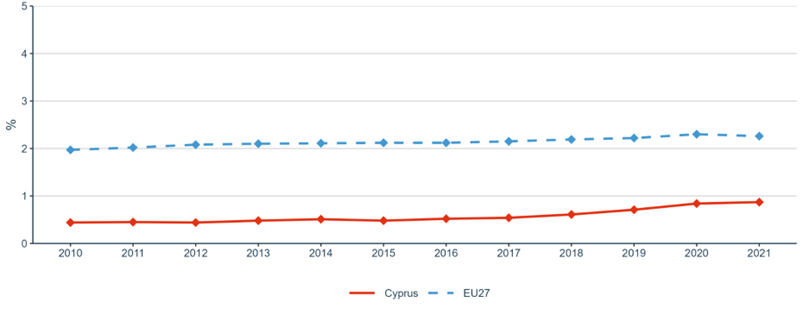
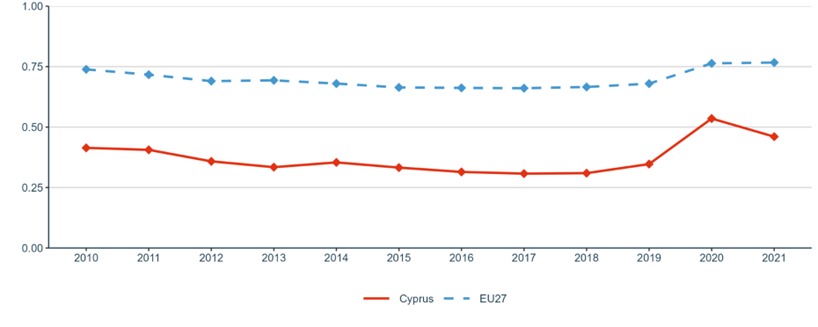
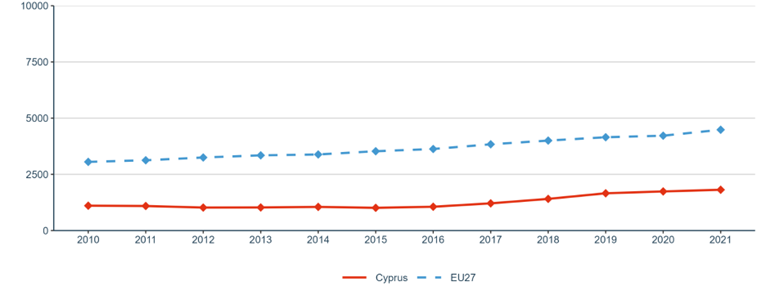
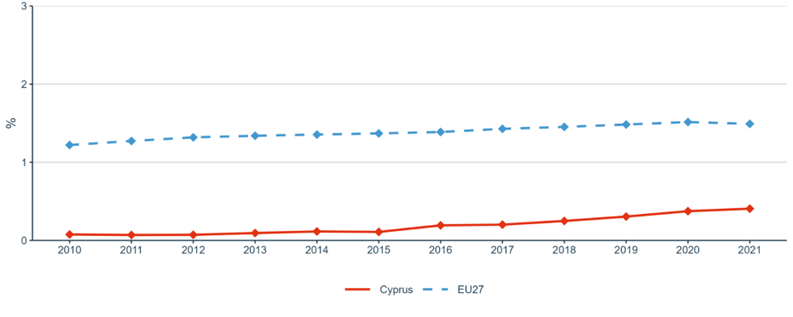
Priority 1: Deepening a truly functioning internal market for knowledge
Sub-priority 1.1: Open Science
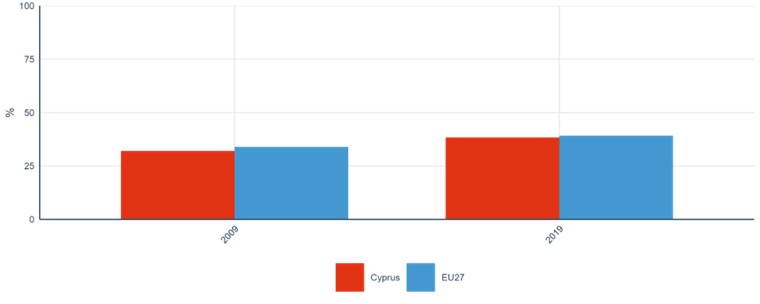
Sub-priority 1.2: Research infrastructures

Sub-priority 1.3: Gender equality, equal opportunities for all and inclusiveness
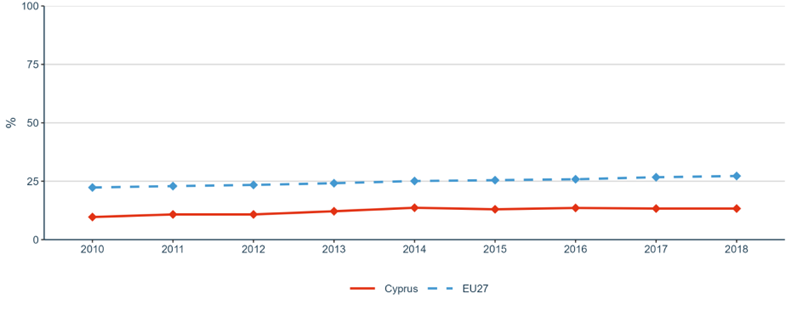

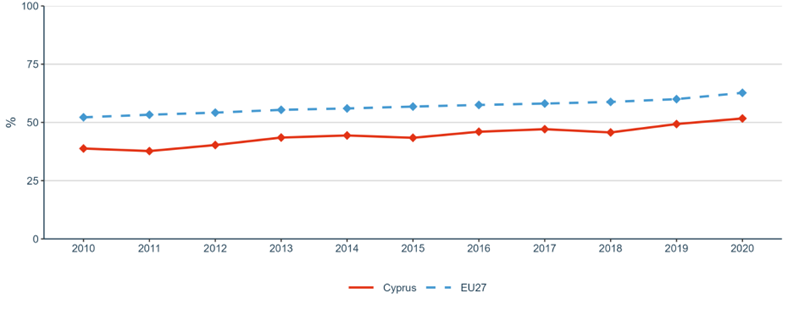


Sub-priority 1.4: Researchers’ careers and mobility and research assessment and reward systems
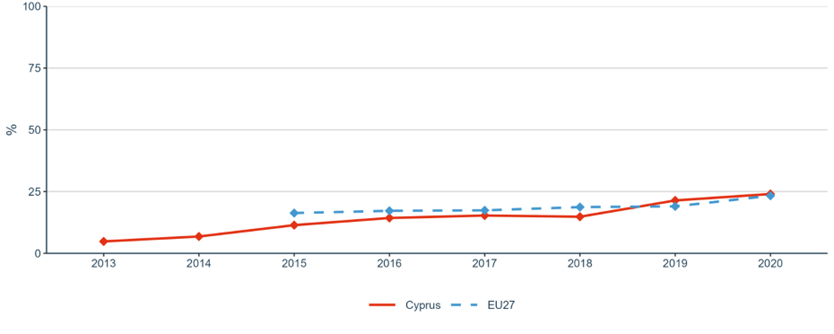


Sub-priority 1.5: Knowledge valorisation

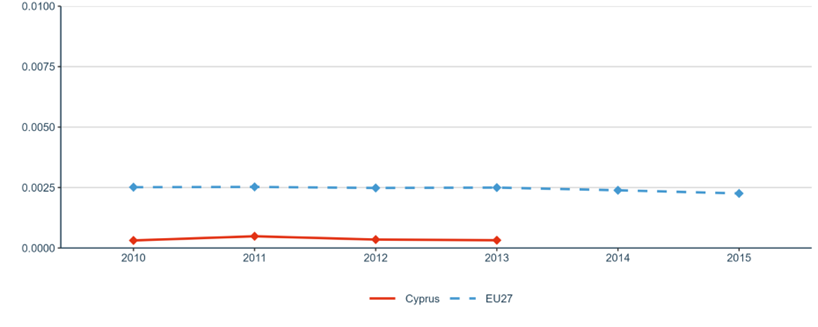
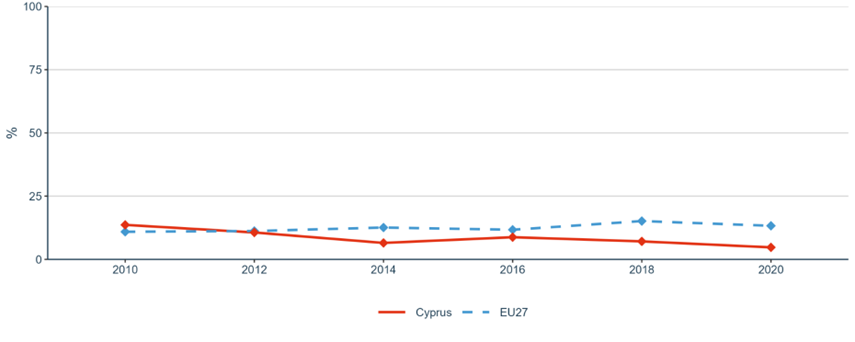
Sub-priority 1.6: Scientific leadership
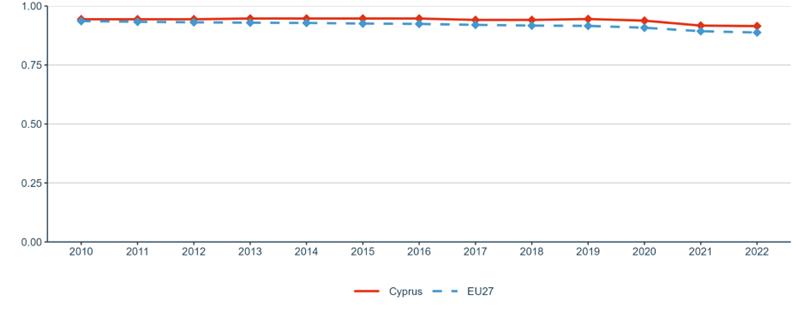
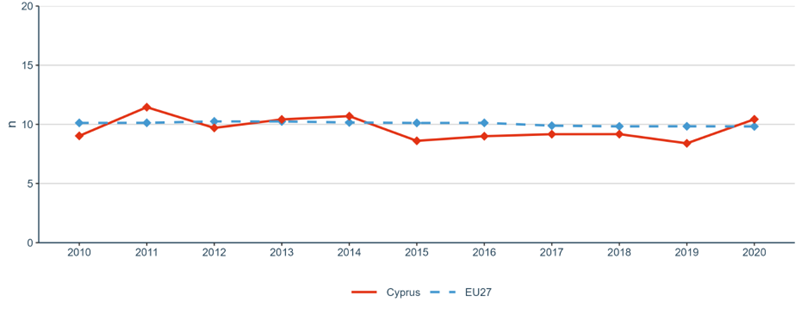
Sub-priority 1.7: Global engagement


Priority 2: Taking up together the challenges posed by the twin green and digital transition and increasing society’s participation in the ERA
Sub-priority 2.1: Challenge-based ERA actions

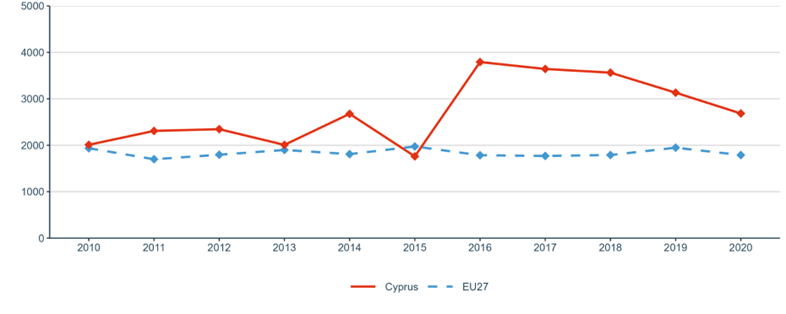


Sub-priority 2.3: Synergies with sectorial policies and industrial policy, in order to boost innovation ecosystems

Sub-priority 2.4: An active citizen and societal engagement in R&I in all its dimensions
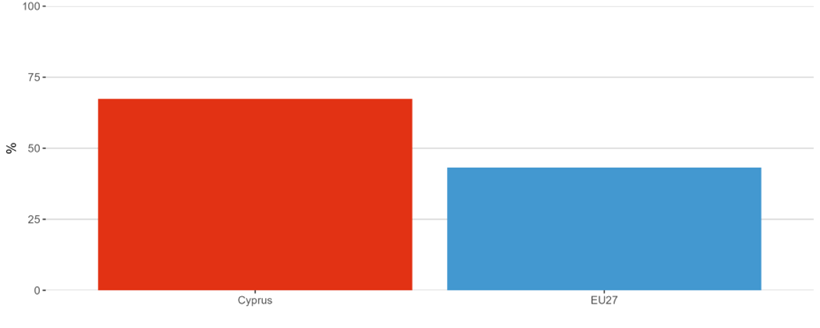

Priority 3: Amplifying access to research and innovation excellence across the Union
Sub-priority 3.1: More investments and reforms in countries and regions with lower R&I performance
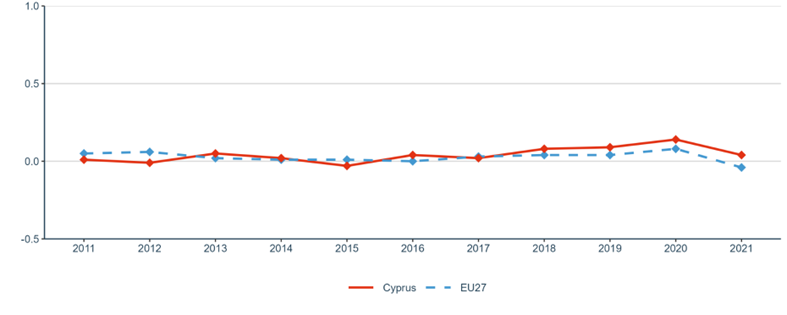
Priority 4: Advancing concerted research and innovation investments and reforms
Sub-priority 4.1: Coordination of R&I investments
